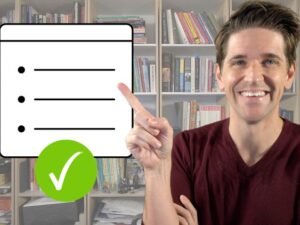- 030 244 2330
- info@preconceptacademy.com
Complete IELTS Academic Preparation to achieve 7+, Free book
- Description
- Curriculum
- FAQ
- Reviews
This is a complete preparation guide to the IELTS Academic test in just 7 hours. The 56 short, clear, and informative lectures of the IELTS Elephant course give detailed explanations with lots of examples of all question types to prepare you for the test and help you succeed in IELTS with a high band score.
The IELTS Elephant is based on tried and tested IELTS techniques and strategies with Dina Panayi, your instructor, who has been using them for over 20 years with great success. The high pass rate in IELTS and positive student reviews testify to the fact that her students are both successful in achieving their goals and find the lessons both enjoyable and interesting. Apart from an experienced IELTS teacher, Dina is also an IELTS examiner, so she knows exactly what you need to pass IELTS with a 7 or higher band score.
Provided with this complete IELTS course is a FREE course pdf book with a copy of all the material in the course and a transcript. Extra practice material is included as well as model answers to the Speaking and Writing Task 1 and 2 questions. To get the free book, you would need to provide your name & email address. Then you will receive an email from Dina with the download link of the free course book. Use this book to practice the IELTS techniques, strategies and tips taught in the course and achieve a 7+ IELTS band score in each module. You can find the instructions on how to download the book in the resources of the Bonus Lecture.
Find what you will learn in this course in more detail below:
In the Reading module, you will learn
-
Skimming and scanning techniques to save time and find the answer quickly in the text
-
Tips for how to answer all IELTS question types from True – False – Not Given to matching headings and multiple-choice questions
-
How to be sure you have chosen the correct answer
-
How to deal with long texts and unfamiliar vocabulary
In the Listening module, you will learn
-
What to expect in the four sections of the IELTS Listening test
-
How to answer all different question types
-
How to predict the kind of answer you are listening for
-
How to avoid leaving a blank by making an educated guess
In the Writing Task One module, you will learn
-
How to summarize the valuable information on all types of diagrams and charts
-
How to identify the main trends and write an overview (the “elephant”)
-
The appropriate language to describe, compare the information
-
How to structure your response in a logical way
-
How to use a wide range of grammatical structures
In the Writing Task Two module, you will learn
-
How to analyze and structure all types of IELTS Writing Task Two questions
-
The vocabulary and grammatical structures needed to achieve a high band score
-
How to check your essay using the Writing band descriptors
-
And you will find many model essays that follow the given structures
In the Speaking module, you will learn
-
How to answer questions in all 3 parts of the IELTS speaking test
-
How to expand your answer and speak fluently
-
How to avoid long pauses using fillers
-
The most common general IELTS speaking topics
-
Useful vocabulary for common IELTS speaking questions
-
And you will find many model answers of common questions
Note: You don’t need to be familiar with the format of the IELTS test since this is something that is explained in the course.
Note: This is a strategy and techniques course to help you pass the IELTS test successfully. There is advice on grammar, vocabulary, and overall English language skills, but the focus is NOT on general English language learning.
Note: There is prompt availability for further questions about the course or for an explanation of any points relating to the material or about the IELTS test.
Note: This is preparation for the IELTS Academic test. The course can still help you prepare for the IELTS General test, but the examples given for the Writing Task 1 are only for the Academic test.
-
2Welcome to ListeningVideo lesson
Welcome to the IELTS Listening test!
-
3Introduction to ListeningVideo lesson
Learn what to expect in each of the four sections in the Listening test and the most common question types.
-
4Predict your answersVideo lesson
Learn to predict the kind of answer you need before the recording begins.
-
5Multiple Choice QuestionsVideo lesson
How to approach Multiple Choice questions and avoid traps.
-
6Labelling a MapVideo lesson
Learn useful tips, common words of direction and compass vocabulary for labelling a Map in the Listening test.
-
7Listening for changes in speechVideo lesson
Learn how the expression of the speaker can help you identify the answer.
-
8Listening Tips & PracticeVideo lesson
Some extra listening tips for choosing and writing down the correct answer. You can also find a band calculator to predict what you can expect in the Listening Test.
-
9ConclusionVideo lesson
-
10Listening RecapQuiz
This is a quiz to test what you've learned in the Listening module. Please select whether the statement is True or False.
-
11Beware of TrapsText lesson
-
12Predicting the AnswerText lesson
-
13LISTENING TEST 1: PART 1, Questions 1-10Text lesson
-
14LISTENING TEST 1: PART 2, Questions 11-20Text lesson
-
15LISTENING TEST 1: PART 3, Questions 21-30Quiz
Choose the correct letter. A, B or C.
-
16LISTENING TEST 1: PART 4, Questions 31-40Text lesson
-
17LISTENING TEST 2: PART 1, Questions 1-10Text lesson
-
18LISTENING TEST 2: PART 2, Questions 11-14Quiz
Choose the correct answer A, B or C.
-
19LISTENING TEST 2: PART 2, Questions 15-20Text lesson
-
20LISTENING TEST 2: PART 3, Questions 21-26Quiz
Choose the correct letter A, B and C.
Work experience for veterinary science students
-
21LISTENING TEST 2: PART 3, Questions 27-30Text lesson
-
22LISTENING TEST 2: PART 4, Questions 31-40Text lesson
-
23Introduction to ReadingVideo lesson
A brief overview of the Reading test
-
24How to skim a Reading PassageVideo lesson
Save time by skimming down the passage and highlighting words that stand out.
-
25Using Keywords to find the answerVideo lesson
The importance of keywords and synonyms in finding the answer quickly.
-
26Matching headings to paragraphVideo lesson
How to choose the most appropriate heading to summarise the paragraph and verifying your answer.
-
27Summary Gap fillingVideo lesson
Choose the correct words from the text to fill the gaps in the questions.
-
28Answer True - False - Not givenVideo lesson
Identify whether the statement is True/False or Not Given or Yes/No/Not Given according to the passage.
-
29Matching Heading to paragraphsVideo lesson
Choose the correct heading from a list of headings that summarises the paragraph.
-
30Answering Multiple Choice QuestionsVideo lesson
Identify the correct option in multiple choice questions and avoid distractors.
-
31Making an Educated GuessVideo lesson
Increase your chances of choosing the correct answer by logical thinking.
-
32Labelling a DiagramVideo lesson
Locate the relevant parts of a diagram.
-
33Dealing with Common ProblemsVideo lesson
How to deal with the lack of time and unknown words.
-
34ConclusionVideo lesson
Great job! Best of luck in the IELTS Reading test!
-
35Reading RecapQuiz
This is a quiz to test what you've learned in the Reading module. Please select whether the statement is True or False.
-
36Finding Keywords and Matching SynonymsText lesson
-
37Matching Headings to ParagraphsText lesson
-
38Introduction to Writing Task 1Video lesson
An overview of Writing Task 1
-
39Most Common Task One DiagramsVideo lesson
Introducing the most common diagrams in Task 1
-
40How to Describe a TrendVideo lesson
Useful vocabulary and sentence structure to describe a graph with a trend.
-
41Useful Language for Task OneVideo lesson
Useful language to introduce each paragraph of your summary, linking words and ways to refer to periods of time.
-
42Complete Task One Graph with a TrendVideo lesson
How to describe a complete graph with a trend. Introducing The Elephant!
-
43Other Graphs with TrendsVideo lesson
Practice in describing a bar chart and table with a trend.
-
44How to describe Pie ChartsVideo lesson
How to describe pie charts with past and future trends.
-
45How to describe MapsVideo lesson
Learn how to describe the changes in a map of an area over a period of time.
-
46How to describe FlowchartsVideo lesson
Summarise the stages in a process using passive voice and linking words.
-
47Describing Graphs without TrendsVideo lesson
How to compare the information on a graph without a trend.
-
48Marking Criteria for Task OneVideo lesson
Band descriptors showing what the examiner is looking for when grading Task 1 diagrams and a checklist.
-
49ConclusionVideo lesson
Great job! Best of luck in the IELTS Writing test!
-
50Writing Task 1 RecapQuiz
This is a quiz to test what you've learned in the Writing Task 1 module. Please select whether the statement is True or False.
-
51Describing FlowchartsText lesson
-
52Describing ChangeText lesson
-
53Practise Writing SummariesText lesson
-
54Introduction to Writing Task 2Video lesson
An overview of the three main essay types.
-
55For and Against EssayVideo lesson
How to structure a For and Against essay and generating ideas with the Discussion Clock.
-
56Opinion EssayVideo lesson
How to state and support your opinion in an Opinion essay.
-
57Problem, Cause and Solution EssayVideo lesson
How to write a Problem, Cause and Solution essay.
-
58Other Types of EssayVideo lesson
How to answer an essay with two different questions.
-
59Useful Grammar and VocabularyVideo lesson
Using the Discussion clock to brainstorm ideas for your essay + more interesting vocabulary and grammatical structures for a higher band score.
-
60Practise Essay TopicsVideo lesson
What the examiner is looking for to grade your essay, practice essay questions and a checklist.
-
61ConclusionVideo lesson
Great job! Best of luck in the IELTS Writing test!
-
62Writing Task 2 RecapQuiz
This is a quiz to test what you've learned in the Writing Task 2 module. Please select whether the statement is True or False.
-
63Practise Writing Essay IntroductionsText lesson
-
64Practising paragraph developmentText lesson
-
65Using Linking WordsText lesson
-
66Practise Writing EssaysText lesson
-
67Introduction to SpeakingVideo lesson
A brief introduction to the three parts of the IELTS Speaking test.
-
68Speaking Part OneVideo lesson
Typical part 1 questions and how to answer them
-
69Tips to Expand your answerVideo lesson
How to expand your answer with reasons, giving examples, adding details or contrast.
-
70Speaking Part TwoVideo lesson
Learn the most common Speaking topics for the Long Turn and how to adapt them for more specific topics.
-
71Describe a PersonVideo lesson
Useful vocabulary to describe a specific person and a model answer.
-
72Describe an ObjectVideo lesson
Useful vocabulary to describe a specific object and a model answer.
-
73Describe a PlaceVideo lesson
Useful vocabulary to describe a specific place and a model answer.
-
74Describe an ActivityVideo lesson
Useful vocabulary to describe a specific activity and a model answer.
-
75Describe your FavouriteVideo lesson
Useful vocabulary to describe your favourite book/film/website...and a model answer.
-
76Describe an EventVideo lesson
Useful vocabulary to describe a specific event and a model answer.
-
77Common Topics & TipsVideo lesson
Use online resources to prepare for common and specific topics in Speaking Part 2
-
78Speaking Part 3 & Language BankVideo lesson
How to express and support your opinion in Speaking Part 3 and phrases to avoid hesitation.
-
79Practice and PronunciationVideo lesson
How to speak clearly and use expression in your voice.
-
80Quick RevisionVideo lesson
A quick reminder of what you need to get a high band score in Speaking, a full practice test and the Speaking Band Descriptors.
-
81ConclusionVideo lesson
Great job! Best of luck in the IELTS Speaking test!
-
82Speaking RecapQuiz
This is a quiz to test what you've learned in the Speaking module. Please select whether the statement is True or False.
-
83Practising Part 1 QuestionsText lesson
-
84Practising Part 2 QuestionsText lesson
-
85Practising Part 3 QuestionsText lesson









